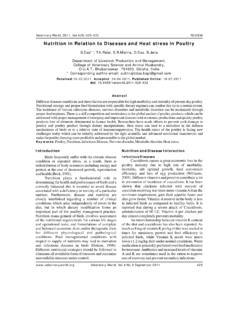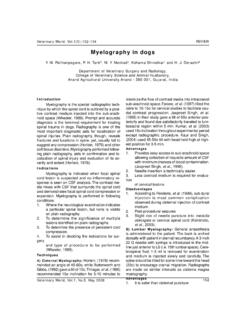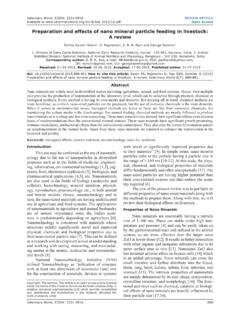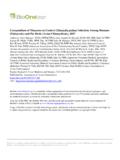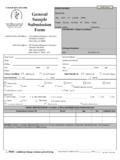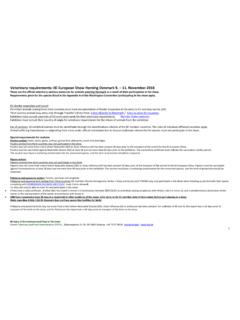Transcription of Common Respiratory Diseases of Poultry - Veterinary World
1 Veterinary World .. , , July 2008 Common Respiratory Diseases of PoultryShankar ,Department of Veterinary Pathology, Veterinary College, Karnataka Veterinary , Animal and Fisheries Science UniversityHebbal, Bangalore-24, IndiaThere are many Common and impor tantdiseases which can affect the Respiratory system (airpassages, lungs, air sacs) of Poultry . People keepthe birds for their use and generally include thechicken, turkey, duck, goose, quail, pheasant,pigeon, guinea fowl, pea fowl, ostrich, emu and Pox/chicken pox/sore head/aviandiphtheria: Most poultr y-chickens, turkeys,pheasants, quail, ducks, psittacine, and ratites - ofall ages are susceptible. There are two forms of fowlpox. The dry form is characterized by raised, wart-like lesions on unfeathered areas (head, legs, vent,etc.). The lesions heal in about 2 weeks. If the scabis removed before healing is complete, the surfacebeneath is raw and bleeding.
2 Unthriftiness andretarded growth are typical symptoms of fowl pox. Inlaying hens, infection results in a transient declinein egg production. In the wet form there are canker-like lesions in the mouth, pharynx, larynx, andtrachea. The wet form may cause Respiratory distressby obstructing the upper air passages. Chickens maybe affected with either or both forms of fowl pox atone pox is transmitted by direct contactbetween infected and susceptible birds or bymosquitos. Virus-containing scabs also can besloughed from affected birds and serve as a sourceof infection. The virus can enter the blood streamthrough the eye, skin wounds, or Respiratory become infected from feeding on birdswith fowl pox in their blood stream. There is someevidence that the mosquito remains infective for are the primary reservoir and spreadersof fowl pox on Poultry ranges. Several species ofmosquito can transmit fowl pox.
3 Often mosquitoswinter-over in Poultry houses so, outbreaks can occurduring winter and early disease / pneumoencephalitis (ND):The highly contagious and lethal form of Newcastledisease is known as viscerotropic (attacks theinternal organs) velogenic Newcastle disease ,VVND, exotic Newcastle disease , or AsiaticNewcastle disease . VVND is not present in theUnited States Poultry industry at this disease affects all birds of all and other mammals are also susceptibleto Newcastle. In such species, it causes a mildconjunctivitis. There are three forms of Newcastledisease, mildly pathogenic (lentogenic), moderatelypathogenic (mesogenic) and highly pathogenic(velogenic). Newcastle disease is characterized bya sudden onset of clinical signs which include hoarsechirps (in chicks), watery discharge from nostrils,labored breathing (gasping), facial swelling,paralysis, trembling, and twisting of the neck (signof central nervous system involvement).
4 Mortalityranges from 10 to 80 percent depending on thepathogenicity. In adult laying birds, symptoms caninclude decreased feed and water consumption anda dramatic drop in egg Newcastle virus can be transmitted shortdistances by the airborne route or introduced oncontaminated shoes, caretakers, feed deliverers,visitors, tires, dirty equipment, feed sacks, crates,and wild birds. Newcastle virus can be passed inthe egg, but Newcastle-infected embryos die beforehatching. In live birds, the virus is shed in body fluids,secretions, excreta, and Bronchitis/ (IB): Infectious bronchitisis a disease of chickens only. A similar diseaseoccurs in bobwhite quail (quail bronchitis), but it iscaused by a different virus. The severity of infectiousbronchitis infection is influenced by the age andimmune status of the flock, by environmentalconditions, and by the presence of other and water consumption declines.
5 Affectedchickens will be chirping, with a watery dischargefrom the eyes and nostrils, and labored breathingwith some gasping in young chickens. Breathingnoises are more noticeable at night while the birdsrest. Egg production drops dramatically. Productionwill recover in 5 or 6 weeks, but at a lower rate. Theinfectious bronchitis virus infects many tissues of thebody, including the reproductive tract. EggshellsVeterinary World , (7): 217-219 REVIEW217 Veterinary World .. , , July 2008become rough and the egg white becomes : Infectious bronchitis is a ver ycontagious Poultry disease . It is spread by air, feedbags, infected dead birds, infected houses, androdents. The virus can be egg-transmitted, however,affected embryos usually will not is no specific treatment for infectiousbronchitis. Antibiotics for 3-5 days may aid incombating secondary bacterial infections. Raise theroom temperature 5 F for brooding-age chickensuntil symptoms subside.
6 Baby chicks can beencouraged to eat by using a warm, moist Influenza (AI) influenza: Avian influenzacan occur in most, if not all, species of birds. Avianinfluenza is categorized as mild or highly mild form produces listlessness, loss of appetite, Respiratory distress, diarrhea, transient drops in eggproduction, and low mortality. The highly pathogenicform produces facial swelling, blue comb and wattles,and dehydration with Respiratory distress. Dark red/white spots develop in the legs and combs ofchickens. There can be blood-tinged discharge fromthe nostrils. Mortality can range from low to near100 percent. Sudden exertion adds to the totalmortality. Egg production and hatchability can be an increase in production of soft-shelled and shell-less avian influenza virus can remain viablefor long periods of time at moderate temperaturesand can live indefinitely in frozen material. As a result,the disease can be spread through improperdisposal of infected carcasses and manure.
7 Avianinfluenza can be spread by contaminated shoes,clothing, crates, and other equipment. Insects androdents may mechanically carry the virus frominfected to susceptible Coryza/ roup: Chickens, pheasants,and guinea fowl. Common in game chicken around the face, foul smelling, thick, stickydischarge from the nostrils and eyes, laboredbreathing, and rales (rattles - an abnormal breathingsound) are Common clinical signs. The eyelids areirritated and may stick together. The birds may havediarrhea and growing birds may become from coryza is usually low, but infectionscan decrease egg production and increase theincidence and/or severity of other Diseases . Mortalitycan be as high as 50 percent, but is usually no morethan 20 percent. The clinical disease can last from afew days to 2-3 months, depending on the virulenceof the pathogen and the existence of other infectionssuch as is primarily transmitted by direct bird-to-bird contact.
8 This can be from infected birdsbrought into the flock as well as from birds whichrecover from the disease which remain carriers ofthe organism and may shed intermittently throughouttheir Birds risk exposure at Poultry shows, birdswaps, and live-bird sales. Inapparent infected adultbirds added into a flock are a Common source foroutbreaks. Within a flock, inhalation of airbornerespiratory droplets, and contamination of feed and/or water are Common modes of Laryngotracheitis (ILT): Chickens andpheasants are affected by LT. Chickens 14 weeksand older are more susceptible than young LT outbreaks occur in mature hens. In recentyears, LT has also caused significant respiratoryproblems in broilers greater than 3 weeks of age,especially during the cooler seasons of the year. Thisis believed to be due to unwanted spread of LTvaccines between Poultry flocks. The clinical signusually first noticed is watery eyes.
9 Affected birdsremain quiet because breathing is difficult. Coughing,sneezing, and shaking of the head to dislodgeexudate plugs in the windpipe follow. Birds extendtheir head and neck to facilitate breathing (commonlyreferred to as pump handle respiration ). Inhalationproduces a wheezing and gurgling sound. Blood-tinged exudates and serum clots are expelled fromthe trachea of affected birds. Many birds die fromasphyxiation due to a blockage of the trachea whenthe tracheal plug is is spread by the Respiratory route. LT is alsospread from flock to flock by contaminated clothing,shoes, tires, etc. Birds that recover should be consid-ered carriers for life. LT may be harbored in specialitypoultry such as exhibition birds and game ornithosis/ psittacosis/ parrotfever:The disease was called psittacosis or parrotfever when diagnosed in psittacine (curve-beaked)birds, and called ornithosis when diagnosed in allother birds or in humans.
10 Currently, the termchlamydiosis is used to describe infections in anyanimal. Affected species include turkeys, pigeons,ducks, psittacine (curve-beaked) birds, captive andaviary birds, many other bird species, and otheranimals. Chickens are not commonly are susceptible, especially older andimmunosuppressed individuals who are at a higherrisk. Chlamydiosis in humans is an occupationaldisease of turkey growers, haulers, and processingworkers in the live-bird areas and of workers in pet-bird aviaries although the incidence is rare. ClinicalsignsCommon Respiratory Diseases of Poultry218 Veterinary World .. , , July 2008in most birds include nasal-ocular discharge,conjunctivitis, sinusitis, diarrhea, weakness, loss ofbody weight, and a reduction in feed turkeys there is also Respiratory distress and looseyellow to greenish-yellow colored runs rather slowly through turkeyflocks, with a maximum incidence of around 50%.
